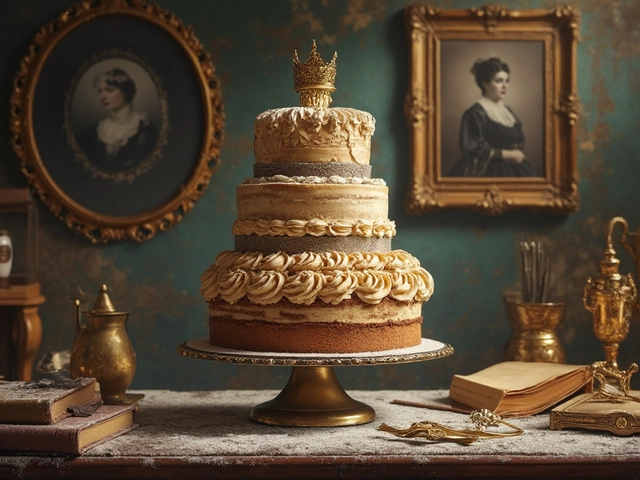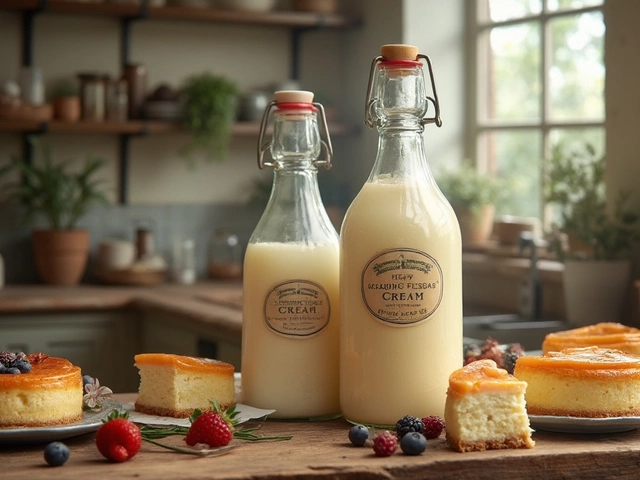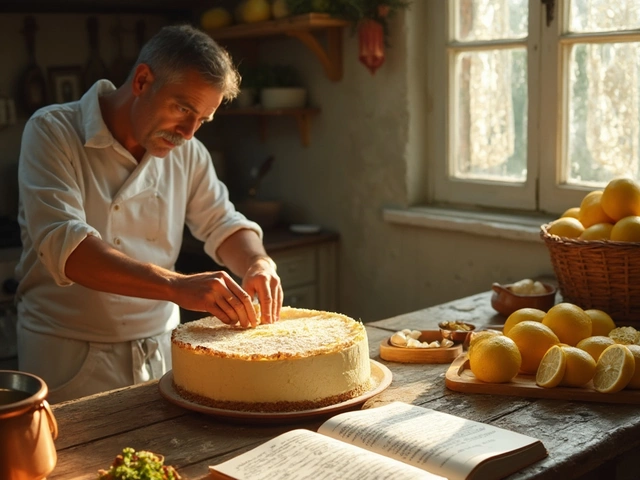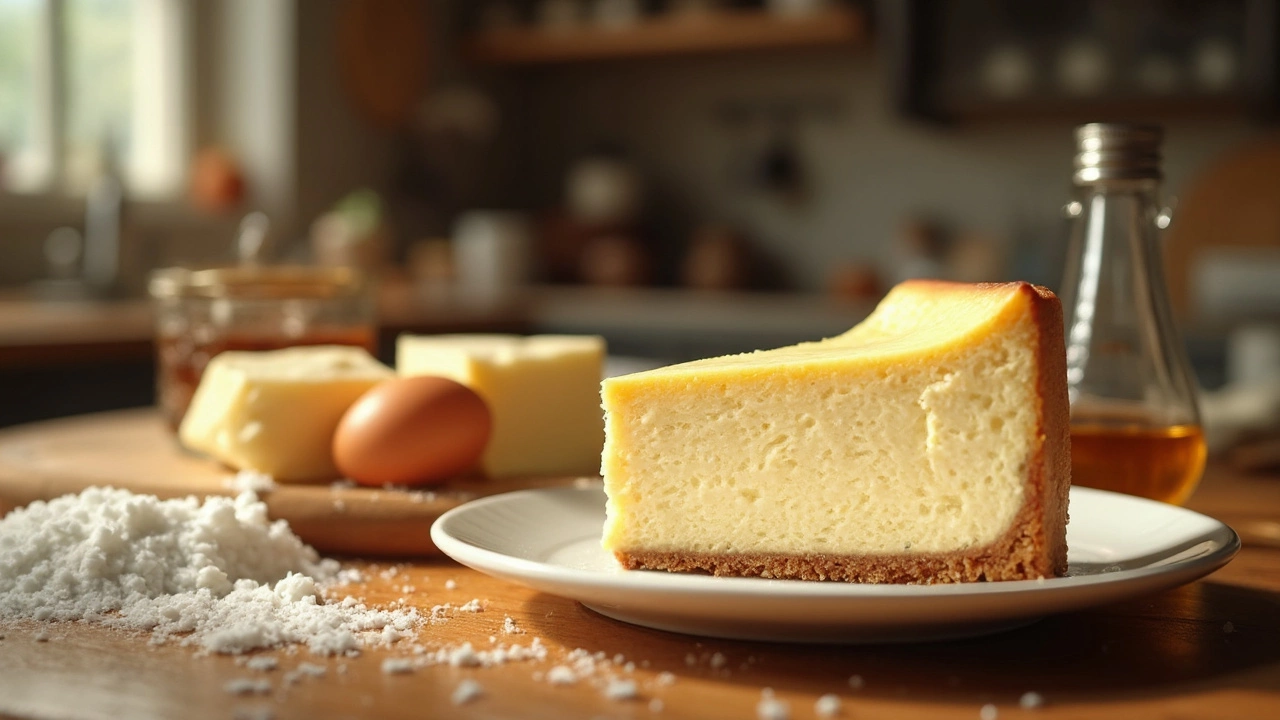
You can spot a New York cheesecake from a mile away. It’s taller, denser, and richer than anything you’ll find at the grocery store. What exactly is inside this dessert powerhouse?
The magic starts with full-fat cream cheese. Not the low-fat stuff, not even Neufchâtel—just stick with the classic block kind. If you grab anything else, you’ll lose that signature creamy texture.
But cream cheese alone won’t cut it. Traditional New York style also calls for eggs, sugar, and a bit of heavy cream or sour cream. The eggs help hold everything together and give the cheesecake that decadent, custardy bite. A splash of vanilla extract is basically non-negotiable for the right aroma.
The crust? Classic graham crackers, crushed and mixed with melted butter and just a pinch of sugar. Some people mix in digestive biscuits or go wild with Oreos, but for pure New York, graham cracker is the gold standard.
Once you know these basic building blocks, it’s a lot less intimidating to try making a cheesecake at home. The rest is all about how you bring these ingredients together and a few tricks to get the best results. Ready to see what sets New York style apart?
- The Essential Ingredients
- Why Cream Cheese Matters
- Eggs, Sugar, and Sour Cream: The Supporting Cast
- Crust Choices: Graham Crackers and Beyond
- Secret Tips for Texture and Flavor
- Frequently Asked Questions
The Essential Ingredients
If you’re aiming for an authentic New York cheesecake, you’ve got to be picky about what goes into the bowl. These aren’t just suggestions; each ingredient pulls serious weight and messing around with them changes everything from taste to texture.
Here’s the classic lineup you can count on for the real deal:
- Cream cheese: Always use full-fat, brick-style cream cheese. Tub versions and low-fat options give you a runny mess and don’t hold the signature structure. Each standard 9-inch cheesecake usually requires about 900g (that’s four 8-oz blocks).
- Sugar: Regular granulated sugar sweetens the filling without messing with the creamy texture. Most recipes need between 1 and 1½ cups, depending on your sweet tooth.
- Eggs: Go for large eggs, usually four to five, to set the cheesecake and give it that smooth, rich interior. Don’t skip them, and don’t try to swap in replacements.
- Sour cream or heavy cream: A cup of full-fat sour cream or about ½ cup of heavy cream goes into the mix for added richness and that velvety finish. Sour cream is the old-school choice, but some bakers swear by heavy cream for extra silkiness.
- Vanilla extract: Just a couple teaspoons do the trick, but real vanilla adds depth and makes the whole thing taste bakery-worthy.
- Graham cracker crumbs: These make up the classic cheesecake crust. You’ll crush about 1½ cups worth (around 12 crackers), add a few tablespoons of sugar, and bind it all with melted butter.
Some New York cheesecakes include a touch of flour or cornstarch. This isn’t universal, but it can help keep the cake from cracking—even iconic places like Junior’s Bakery use a little cornstarch.
For a quick comparison, here’s what usually goes into each main layer:
| Layer | Key Ingredients |
|---|---|
| Filling | Cream cheese, sugar, eggs, sour cream/heavy cream, vanilla |
| Crust | Graham cracker crumbs, melted butter, sugar |
Stick to these basics and you’ll land that iconic New York cheesecake flavor every time. It’s really about quality ingredients and getting your ratios right. Pretty simple, but each part matters big time.
Why Cream Cheese Matters
When it comes to New York cheesecake, cream cheese isn’t just an ingredient—it’s the star of the show. This isn’t like those lighter cheesecakes you sometimes see outside New York; here, we want full, bold flavor and serious richness. That comes straight from the cream cheese.
The kind you buy actually makes a noticeable difference. Most bakers swear by Philadelphia brand (the original block style, not the spreadable tub version). Block-style cream cheese has less water and more fat. More fat means a creamier, denser texture—exactly what you want in a classic cheesecake recipe. If you reach for a tub or a low-fat version, your cheesecake can end up runny or oddly textured. Not a good look.
Here’s a quick breakdown of why full-fat block cream cheese wins:
- Richness: Plenty of fat gives the cake body, so each bite feels velvety and smooth.
- Structure: Less water prevents the cake from turning out soupy or cracking super easily.
- Flavor: Full-fat cream cheese just tastes richer and more “New York”—that’s a flavor you can’t fake!
Some folks try swapping in mascarpone or Neufchâtel for part of the recipe. While those can be good for certain desserts, they’ll never deliver the same iconic tang and texture of real cream cheese. If you want true New York cheesecake, don’t cut corners on this part.
Here’s something fun: a standard 9-inch New York cheesecake will usually call for around 2 pounds (that’s four 8-ounce blocks!) of cream cheese. That’s not a typo. No other cheesecake style uses as much, and it’s the main reason New York cheesecake is so famously decadent.
| Ingredient | Typical Amount (9-inch cake) |
|---|---|
| Cream Cheese (full-fat blocks) | 32 oz (4 blocks) |
| Eggs | 4 large |
| Sugar | 1 to 1¼ cups |
| Sour Cream or Heavy Cream | 1 cup |
So if you’re out shopping, don’t get sidetracked—go straight for the full-fat blocks and grab plenty. The cream cheese is what makes your New York cheesecake unforgettable.
Eggs, Sugar, and Sour Cream: The Supporting Cast
Let’s dig into the parts of New York cheesecake that usually don’t get as much spotlight as cream cheese but are just as crucial for the final flavor and texture. If you leave these out or swap them wrong, you’ll get something more like a cheese-flavored brick or a sad pudding instead of that silky New York classic.
First up: eggs. Most recipes use about 3 to 4 large eggs for a standard 9-inch cheesecake. They do more than just bind everything together. Eggs make the batter smooth and hold in all the air, helping your cheesecake puff up a bit in the oven and set up just right. Too few eggs? The cake falls flat and cracks. Too many? You risk a rubbery texture. Always add eggs one at a time, mixing gently. Over-beating them brings in extra air and can cause cracks when you bake the cake.
Sugar isn’t just about making the cheesecake sweet. It also changes the texture. Classic New York cheesecake uses regular granulated sugar, with the usual range sitting at 1 to 1⅓ cups. Sugar helps keep the cheesecake moist and gives it that familiar golden top. Some bakers try brown sugar or add a little powdered sugar, but sticking with the classic keeps things simple and reliable.
Sour cream (sometimes swapped with heavy cream) is the unsung hero that gives New York cheesecake its signature tang and extra creaminess. That slight sour kick balances all the heaviness, so you don’t feel like you’re eating straight-up frosting by the forkful. Typical recipes use a full cup. Don’t skip it. Swapping for thick Greek yogurt works in a pinch, but you’ll lose a bit of the unique flavor. Here’s a snapshot of how traditional supporting ingredients stack up:
| Ingredient | Usual Amount (for 9-inch cake) | Why It Matters |
|---|---|---|
| Eggs | 3–4 large | Structure, texture, sets the cake |
| Granulated Sugar | 1–1⅓ cups | Sweetness, moisture, golden top |
| Sour Cream | 1 cup | Creaminess, tangy flavor, moisture |
If you want to play it safe, measure everything carefully. Resist the urge to cut corners or wing it. For a true New York cheesecake experience, these supporting ingredients make all the difference—the kind your taste buds will notice right away.
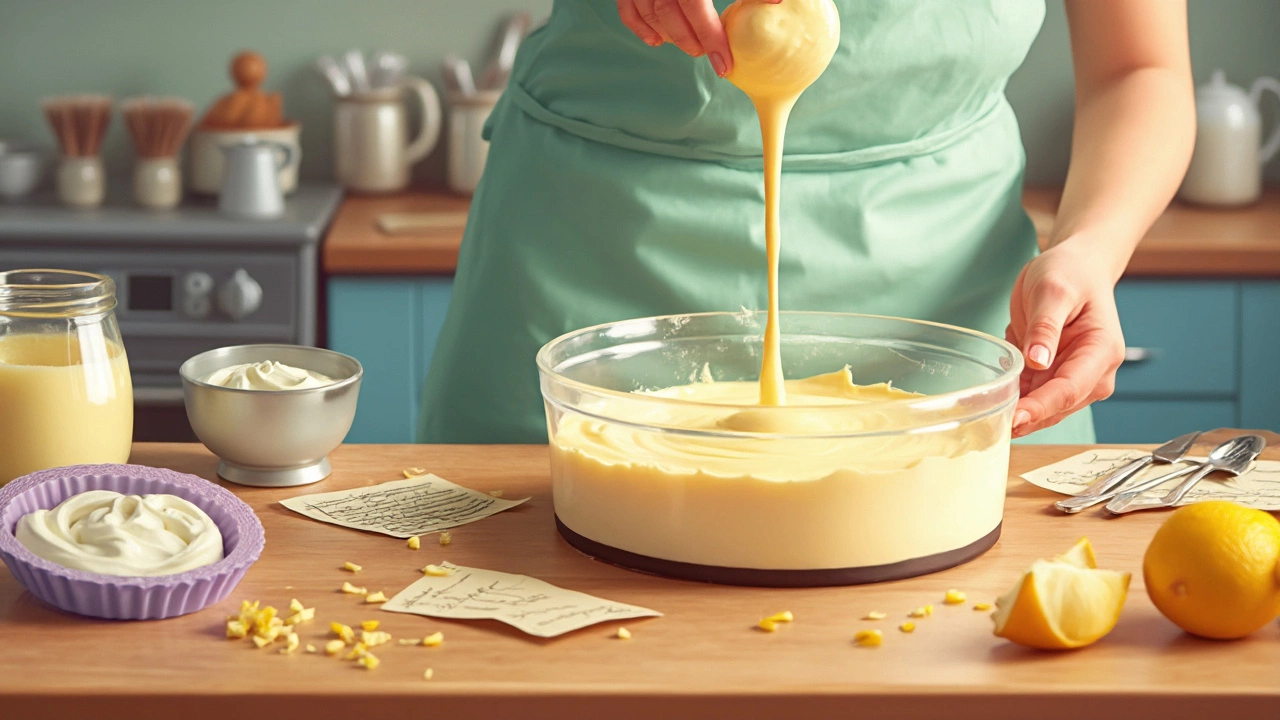
Crust Choices: Graham Crackers and Beyond
The classic New York cheesecake crust is built on crushed graham crackers. There’s a reason for it—graham crackers have a mild, nutty sweetness that doesn’t overpower the rich filling. Mixed with melted butter and just a bit of sugar, they form a sturdy base that stays crisp without getting soggy. You’ll usually need about 1 and 1/2 cups of graham cracker crumbs and 1/4 cup of melted butter for a standard 9-inch pan.
If you can’t get graham crackers, no worries. Here are a few swaps people use that actually work:
- Digestive biscuits: Popular in the UK, they’ve got a similar texture and slightly less sugar, so you might want to add a pinch extra.
- Oreo cookies: For a more intense, chocolate-driven crust, just toss out the filling and crush the cookies. It’s a popular choice for chocolate lovers.
- Shortbread cookies: These bring a buttery, crumbly texture. You’ll end up with a richer, more decadent crust.
- Vanilla wafers: Sweet and mild with a hint of vanilla, these pair well if you want something delicate and less crunchy.
No matter which you pick, the process is always the same: crush the cookies or crackers (food processor or a plastic bag and a rolling pin), mix the crumbs with melted butter and a little sugar, and press the mix firmly into the pan. Some people like to pre-bake the crust for 10 minutes at 350°F to help it set and stay crisp, especially with cookies that are naturally softer.
Crust Thickness Comparison:
| Crust Base | Typical Thickness |
|---|---|
| Graham Crackers | 1/4 inch |
| Digestive Biscuits | 1/4 inch |
| Oreo Cookies | 1/3 inch |
| Shortbread Cookies | 1/3 inch |
It’s easy to get creative with the crust, but if you want that authentic New York cheesecake flavor, graham crackers are still the go-to. Still, don’t be afraid to switch it up. The crust is a low-risk way to tweak a cheesecake recipe and put your own twist on it.
Secret Tips for Texture and Flavor
Ever wonder why your homemade cheesecake doesn’t taste quite like the one from that fancy New York bakery? It usually comes down to a few key moves in the kitchen. If you truly want that legendary New York cheesecake silkiness, don’t skip these steps.
First up: room temperature ingredients. If your cream cheese, eggs, and even your sour cream are cold, you’ll get lumps no matter how long you mix. Set everything out at least an hour before you start. That’s not just a suggestion—it really makes a difference for a super smooth batter.
Mixing is huge. You want everything just blended and no more. Overmix and you’ll whip in air, which causes cracks and a weird, fluffy texture. So beat on low until it’s barely combined. Scrape the sides of the bowl often to catch all the sticky cream cheese bits.
Bake it low and slow. Most New York cheesecakes bake at 300°F or so, way lower than a typical cake. And here’s the game-changer: use a water bath (bain-marie). Wrap your springform pan with foil, set it in a roasting pan, and pour in hot water until it comes halfway up the pan. The steam keeps the oven humid and stops the top from cracking.
- If you want ultimate creaminess, try swapping in a little heavy cream for some of the sour cream.
- Don’t skip the cooling process. Let the cheesecake cool in the oven with the door cracked open for about an hour, then bring it to room temp before chilling. This keeps the texture dense but velvety.
- A day in the fridge will improve both flavor and firmness. The wait can do wonders.
If you like data, a New York cheesecake is usually made up of about 70% cream cheese by weight. That’s a lot compared to regular cheesecake, which explains why it’s so rich and tangy.
| Ingredient | Role in Texture & Flavor |
|---|---|
| Cream Cheese | Main body, creamy texture, tangy flavor |
| Eggs | Gives structure, helps set the cake |
| Sour Cream/Heavy Cream | Adds softness and extra richness |
| Vanilla Extract | Boosts aroma and flavor depth |
If you get these basics right, you’re already ahead of the game. Making a killer cheesecake recipe is more about nailing the process than any wild secret ingredient.
Frequently Asked Questions
People have all sorts of questions about New York cheesecake, especially if they're getting ready to bake one themselves. Let’s answer the stuff that actually comes up, so you’re not left guessing.
1. Can I use low-fat cream cheese?
If you’re aiming for that true New York cheesecake vibe, regular full-fat cream cheese is the way to go. Low-fat versions tend to make the cheesecake watery and dense in a bad way. Serious Eats chef J. Kenji López-Alt says,
"Don’t skimp on the fat. Richness is the backbone of a true New York cheesecake, and that starts with traditional cream cheese."
2. What’s the difference between regular and New York cheesecake?
Standard cheesecakes usually use less cream cheese and thinner layers. A New York cheesecake is tall, extra creamy, and dense, usually because it adds extra egg yolks or sour cream to the filling. It’s famous for its heavy, velvety bite—you can thank the classic ingredient ratios for that.
3. Do I need to use a water bath?
A water bath (bain-marie) helps prevent cracks by keeping the baking temperature steady and gentle. Not everyone bothers, but if you want that perfectly smooth top, it’s worth the extra step. Wrap your springform pan in foil before popping it in the water, so nothing leaks.
4. Why does my cheesecake crack?
- Overbaking: Take it out while the center is still a little jiggly.
- Too much mixing: Go easy on the beating after adding eggs, or you’ll trap air.
- No water bath: The direct high heat makes cracks more likely.
5. Can I freeze New York cheesecake?
Absolutely. Just wrap slices tightly in plastic wrap and foil, and they’ll keep in the freezer for up to two months. Thaw in the fridge for the best texture.
6. How many calories in a typical slice?
| Cheesecake Type | Calories (per 1/12 slice) |
|---|---|
| New York style | 420–480 |
| Regular (lighter style) | 310–370 |
7. Can I swap in Greek yogurt or mascarpone?
Some people do. Greek yogurt can lighten up the filling, but it changes both taste and texture. Mascarpone makes it silkier but less tangy. If it’s your first time baking New York cheesecake, stick with regular cream cheese and branch out only after you get the basics down.


